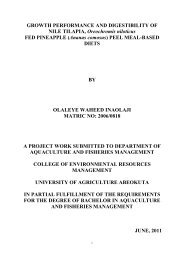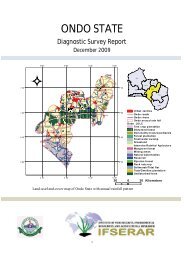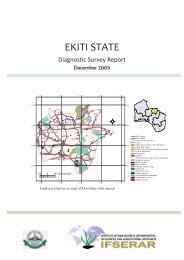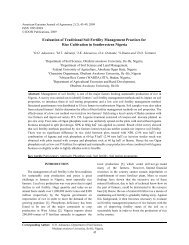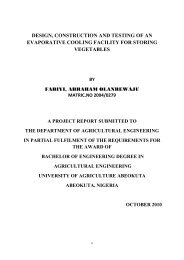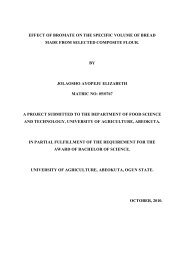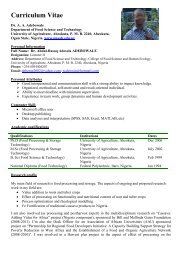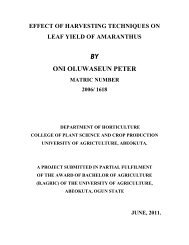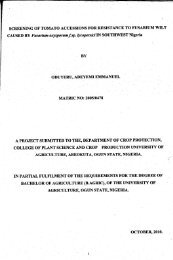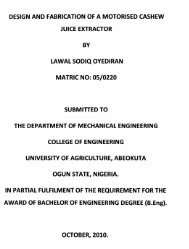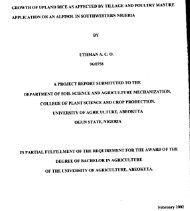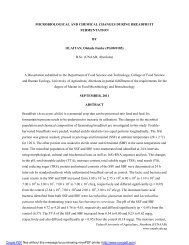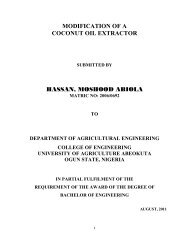remediation of crude oil and spent oil polluted soils using compost ...
remediation of crude oil and spent oil polluted soils using compost ...
remediation of crude oil and spent oil polluted soils using compost ...
You also want an ePaper? Increase the reach of your titles
YUMPU automatically turns print PDFs into web optimized ePapers that Google loves.
CHAPTER 4<br />
RESULTS<br />
The pH values for <strong>crude</strong> <strong>oil</strong> <strong>and</strong> <strong>spent</strong> <strong>oil</strong> <strong>polluted</strong> s<strong>oil</strong>s before <strong>and</strong> after <strong>remediation</strong> are<br />
presented in Figs.l <strong>and</strong> 2. The range before <strong>remediation</strong> was frotn 6.25 to 6.31; 6.25 to 6.43<br />
for s<strong>oil</strong>s <strong>polluted</strong> with <strong>crude</strong> <strong>oil</strong> <strong>and</strong> those spiked with <strong>spent</strong> engine <strong>oil</strong> respectively <strong>and</strong> 6.09<br />
to 6.13 ; 6.09 to 6.22 respectively after <strong>remediation</strong>. TIle effect <strong>of</strong> applied <strong>compost</strong><br />
technology varied from -0.155 to 7.751 % for s<strong>oil</strong>s <strong>polluted</strong> with <strong>spent</strong> engine <strong>oil</strong> <strong>and</strong> 7.96 to<br />
9.71% for those <strong>polluted</strong> with <strong>crude</strong> <strong>oil</strong>.
7.2<br />
7<br />
6.8<br />
1<br />
Q,l<br />
:J 6.6<br />
iii<br />
><br />
J:<br />
a. 6.4<br />
6.2<br />
• Before spill<br />
• After <strong>remediation</strong><br />
6<br />
5.8<br />
0<br />
7.2<br />
7<br />
6.8<br />
J: a.<br />
6.6<br />
6.4<br />
0<br />
III<br />
6.2<br />
6<br />
• Before spill<br />
• After <strong>remediation</strong><br />
5.8<br />
5.6
4.1.2 Effect <strong>of</strong> <strong>compost</strong> induced <strong>remediation</strong> on s<strong>oil</strong> electrical conductivity<br />
The electrical conductivity values for <strong>crude</strong> <strong>oil</strong> <strong>and</strong> <strong>spent</strong> <strong>oil</strong> <strong>polluted</strong> s<strong>oil</strong>s before <strong>and</strong> after<br />
<strong>remediation</strong> are presented in Figs.3<strong>and</strong> 4. The range before <strong>remediation</strong> was from 159.25 to<br />
150.5 ; 159.25 to 136 for s<strong>oil</strong>s <strong>polluted</strong> with <strong>crude</strong> <strong>oil</strong> <strong>and</strong> those spiked with <strong>spent</strong> engine <strong>oil</strong><br />
respectively <strong>and</strong> 91.75 to 29.75 ; 91.75 to 91 respectively after <strong>remediation</strong>. The effect <strong>of</strong><br />
applied <strong>compost</strong> technology varied from 23.44 to 55.52 % for s<strong>oil</strong>s <strong>polluted</strong> with <strong>spent</strong><br />
engine <strong>oil</strong> <strong>and</strong> 29.82 to 21% for those <strong>polluted</strong> with <strong>crude</strong> <strong>oil</strong>.
300<br />
E 250 u<br />
~<br />
>OJ<br />
.:;<br />
200<br />
~ 150 ;,<br />
"0 C0u<br />
iii 100<br />
u<br />
.-=:<br />
ti<br />
QI<br />
Li:i 50<br />
• Before spill<br />
• After <strong>remediation</strong><br />
0<br />
Fig.3:Electrical conductivity<br />
rate<br />
in s<strong>oil</strong>s <strong>polluted</strong> by <strong>spent</strong> engine <strong>oil</strong> as influenced by applied <strong>compost</strong><br />
250<br />
E 200 u<br />
'"<br />
~>OJ<br />
150 .:;<br />
~ ;,<br />
"0 C0<br />
u 100<br />
iii<br />
u<br />
.-=:<br />
ti<br />
QI 50<br />
Li:i<br />
• Before spill<br />
• After <strong>remediation</strong><br />
0<br />
Fig.4: Electrical conductivity in s<strong>oil</strong>s <strong>polluted</strong> by <strong>crude</strong> <strong>oil</strong> as influenced by applied<br />
<strong>compost</strong> rate
The moisture content values for <strong>crude</strong> <strong>oil</strong> <strong>and</strong> <strong>spent</strong> <strong>oil</strong> <strong>polluted</strong> s<strong>oil</strong>s before <strong>and</strong> after<br />
<strong>remediation</strong> are presented in Table 4. The range before <strong>remediation</strong> was from 0 to 1 ; 1 to 2<br />
for soits <strong>polluted</strong> with <strong>crude</strong> <strong>oil</strong> <strong>and</strong> those spiked with <strong>spent</strong> engine <strong>oil</strong> respectively <strong>and</strong> 2.9 to<br />
22.2 ; 2.8 to 4.95 respectively after <strong>remediation</strong>. The effect <strong>of</strong> applied <strong>compost</strong> technology<br />
varied from 3370 to 2134 for s<strong>oil</strong>s <strong>polluted</strong> with <strong>spent</strong> engine <strong>oil</strong> <strong>and</strong> 989.6 to 1532.8 for<br />
those poHuted with <strong>crude</strong> oiL
TABLE 4: SOIL MOISTURE CONTENT CHANGES AT PRE-CONTAMINATION AND<br />
AFTER REMEDfATION PHASES<br />
S<strong>oil</strong> alone1<br />
S<strong>oil</strong> alone2<br />
S<strong>oil</strong> alone3<br />
S<strong>oil</strong> alone4<br />
Mean<br />
st<strong>and</strong>ard deviation<br />
1.00<br />
LOO<br />
1.00<br />
0.00<br />
0.75<br />
0.01<br />
After<br />
remCOI311Uu\ "/0)<br />
2 SOIL+ CRUDEOIL<br />
S+CD0-D-1<br />
S+CDO-0-2<br />
S+CDO-D-3<br />
S+CDO-0-4<br />
Mean<br />
st<strong>and</strong>ard deviation<br />
1 5.00<br />
t 4.00<br />
0 22.20<br />
t 2.90<br />
0.75 8.53<br />
0.01 0.09<br />
SOIL+CRUDEOIL+COMPOST<br />
675g<br />
S+COO-1-1<br />
t<br />
12.90<br />
S+CDO-1-2<br />
I<br />
11.5&<br />
S+CDO-1-3<br />
2<br />
11<br />
S+CDO-t-4<br />
t<br />
19<br />
Mean<br />
1.25<br />
13.62<br />
st<strong>and</strong>ard<br />
deviation<br />
0-01<br />
0.04<br />
SOIL+CRUDEOIL+COMPOST<br />
810g<br />
S+CD0-2-1<br />
1<br />
19.80<br />
S+CDO-2-2<br />
S+CD0-2-3<br />
S+CDO-2-4<br />
1<br />
o<br />
1<br />
15.53<br />
14<br />
17.82<br />
Mean<br />
0.75<br />
16.79<br />
st<strong>and</strong>ard<br />
deviation<br />
0.01<br />
0.03<br />
5 SOIL+CRUDEOIL+COMPOST 945Q<br />
S+CDO-3-1 1 17<br />
S+CD0-3-2 1 25<br />
S+CDO-3-3 1 40.65<br />
S+CD0-3-4 1 16<br />
Mean 1.00 24.66<br />
st<strong>and</strong>ard deviation \)<br />
.f\ 1<br />
V.•.l..
~nje4 Contd: SOIL MOISTURE CONTENT CHANGES AT PRE-CONT AMINA TlON AND<br />
.POST"CONTAMJNATrON<br />
PHASES<br />
SOIL+CRUDEOIL+COMPOST<br />
l080g<br />
S+CDO-4-1<br />
1<br />
19.20<br />
S+CDO-4-2<br />
8+CDO-4-3<br />
S+CDO-4-4<br />
1<br />
o<br />
1<br />
19.60<br />
13.40<br />
4.70<br />
Mean<br />
0.75<br />
14.23<br />
st<strong>and</strong>ard<br />
deviation<br />
0.01<br />
0.07<br />
SOIL+CRUDEOIL+COrvlPOST<br />
1215g<br />
S+CDO-5-1<br />
1<br />
26.30<br />
S+CDO-5-2<br />
1<br />
19<br />
S+CDO-5-3<br />
2<br />
21.20<br />
S+CDO-5-4<br />
1<br />
15.15<br />
Mean<br />
1.25<br />
20.41<br />
st<strong>and</strong>ard<br />
deviation<br />
0.01<br />
0.05<br />
8 SOIL+SPENTOIi.<br />
8+8EO-O-I 1 2.80<br />
S+SEO-O-2 1 3.00<br />
8+8EO-0-3 2 4.95<br />
S+SEO-0-4 1 4<br />
Mean 1.25 3.69<br />
st<strong>and</strong>ard deviation 0.01 0.01<br />
9 SOIL+SPENTOIL+COMPOST 675g<br />
8+8EO-l-l 0 19.78<br />
S+8EO-I-2 0 13<br />
8+8EO-I-3 1 17.80<br />
S+8EO-I-4 1 18.81<br />
Mean 0.50 17.35<br />
st<strong>and</strong>ard deviation 0.01 0.03<br />
SOIL+8PENTOU,+COMPOST<br />
8IO!!<br />
S+8EO-2-1<br />
1<br />
16.83<br />
8+8 EO-2-2<br />
8+8£0-2-3<br />
8+8EO-2-4<br />
1<br />
o<br />
1<br />
19.78<br />
15.74<br />
18<br />
Mean<br />
0.75<br />
17.59<br />
st<strong>and</strong>ard<br />
deviation<br />
0.01<br />
0.02
SiN Sample codes Before spill After<br />
<strong>remediation</strong><br />
11 SOIL+SPENTOfL +COMPOST 945g<br />
S+SEO-3-1 1 15<br />
S+SEQ..3-2 1 15.53<br />
S+SEQ..3-3 0 16.35<br />
S+SEO-3-4 1 16.83<br />
Mean 0.75 15.93<br />
st<strong>and</strong>ard deviation 0.01 0.01<br />
12 SOlL +SPENTOIL +COMPOST 1080g<br />
S+SEQ..4-1 1 19.19<br />
S+SEO-4-2 1 19<br />
S+SEQ..4-3 2 18<br />
S+8EO-4-4 1 22<br />
Mean 1.25 19.55<br />
st<strong>and</strong>ard deviation 0.01 0.02<br />
13 SOIL +SPENTOTL+COMPOST 1215g<br />
S+SEO-5-1 1 29<br />
8+SEO-5-2 1 21.20<br />
S+SEO-5-3 1 14.14<br />
S+SEO-5-4 1 25<br />
Mean 1.00 22.34<br />
st<strong>and</strong>ard deviation 0 0.06
-<br />
showed inverse relationships for c.ompost applied rate <strong>and</strong> %TPl-I reduction (y= -O.OO6x +
80<br />
Qii<br />
.::J:. 70<br />
lio<br />
.§. 60<br />
SO<br />
z<br />
0 40<br />
6 30<br />
:J 20<br />
cIoU<br />
Ill: 10<br />
:z: 0<br />
Q.<br />
I-<br />
0 tlO tlO tlO tlO tlO<br />
'#. w Ln<br />
,.... 0 Ln 0 Ln<br />
Vl ~ '
80<br />
70<br />
60<br />
~<br />
c 50<br />
0<br />
tl<br />
::J 40<br />
•..<br />
" GI<br />
:I: 30<br />
0..<br />
~<br />
20<br />
• Crude <strong>oil</strong> <strong>polluted</strong> s<strong>oil</strong><br />
• Spent engine <strong>oil</strong> <strong>polluted</strong> s<strong>oil</strong><br />
10<br />
0<br />
Fig.7: Comparative evaluation <strong>of</strong> reduction in total petroleum hydrocarbon (TPH) for s<strong>oil</strong>s<br />
<strong>polluted</strong> with <strong>crude</strong> <strong>oil</strong> <strong>and</strong> <strong>spent</strong> engine <strong>oil</strong> <strong>using</strong> <strong>compost</strong> technology
4.1.5 Effect <strong>of</strong> <strong>compost</strong> induced <strong>remediation</strong> on s<strong>oil</strong> temperature<br />
The s<strong>oil</strong> temperature<br />
values for s<strong>oil</strong>s <strong>polluted</strong> with <strong>crude</strong> <strong>oil</strong> <strong>and</strong> <strong>spent</strong> engine <strong>oil</strong> as<br />
influenced by natural attenuation is contained in Fig.S, the temperature values for s<strong>oil</strong><br />
<strong>polluted</strong> with <strong>crude</strong> <strong>oil</strong> influenced by <strong>remediation</strong> by <strong>compost</strong> technology is contained in<br />
Fig.9, while the temperature values in s<strong>oil</strong> <strong>polluted</strong> by <strong>spent</strong> engine <strong>oil</strong> as influenced by<br />
<strong>remediation</strong> by <strong>compost</strong> technology is contained in Fig. 10.<br />
Results showed that the peak temperature in systems with applied cornpost rates from 675 to<br />
1215 g, either for <strong>spent</strong> engine <strong>oil</strong> <strong>polluted</strong> s<strong>oil</strong>s or <strong>crude</strong> <strong>oil</strong> <strong>polluted</strong> s<strong>oil</strong>s ranged from 39 to<br />
43°C. However, the peak temperature for <strong>polluted</strong> s<strong>oil</strong>s not treated with <strong>compost</strong> were less<br />
than 39°C.
Graph <strong>of</strong> Temperature against Remediation period<br />
for S<strong>oil</strong>, SOIL+SPENT ENGINE OIL, AND<br />
SOIL+CRUDE OIL.<br />
37<br />
CV<br />
~ 35<br />
:J<br />
+J<br />
eCV<br />
CII 33<br />
a.<br />
-+-S<strong>oil</strong> alone<br />
E<br />
~S<strong>oil</strong> (s)+SEO<br />
31<br />
~<br />
•••••••S<strong>oil</strong> (S)+CDO<br />
29<br />
Remediation<br />
period<br />
Fig.S:Temperature <strong>of</strong> s<strong>oil</strong>s <strong>polluted</strong> by <strong>crude</strong> <strong>oil</strong> <strong>and</strong> <strong>spent</strong> engine <strong>oil</strong><br />
attenuation<br />
as influenced by natural
Graph <strong>of</strong> Temperature against Remediation<br />
period for SOIL, SOIL+CRUDE OIL, SOIL+CRUDE<br />
OIL+COMP RATES<br />
37<br />
~S<strong>oil</strong>alone<br />
35<br />
___ S<strong>oil</strong> (s)+CDO<br />
CIJ<br />
•••<br />
::s -,-S+CDO+COMP 675 kg<br />
••••<br />
nJ 33<br />
•••<br />
~S+CDO+COMP 810 kg<br />
CIJ<br />
a.<br />
••.••• S+CDO+COMP945kg<br />
E 31 _S+CDO+COMP 1080kg<br />
{Eo<br />
-+-S+CDO+COMP 1215kg<br />
29<br />
Remediation<br />
period<br />
Fig.9: Temperature<br />
technology<br />
in s<strong>oil</strong>s <strong>polluted</strong> by <strong>crude</strong> <strong>oil</strong> as influenced by <strong>remediation</strong> by <strong>compost</strong>
Graph <strong>of</strong> Temperature against Remediation<br />
period for SOIL, SOIL+SPENT ENGINE<br />
OIL, SOIL+SPENT ENGINE OIL+COMP RATES<br />
45<br />
43<br />
41<br />
39<br />
QI<br />
~<br />
::s 37 ...,<br />
ns<br />
~<br />
QI<br />
Do<br />
E<br />
35<br />
~ 33<br />
31<br />
29<br />
"'-S<strong>oil</strong> (S)+SEO<br />
-a-S+SEO+COMP<br />
~S+SEO+COMP<br />
~S+SEO+COMP<br />
_S+SEO+COMP<br />
-+-S+SEO+COMP<br />
675 kg<br />
810 kg<br />
945kg<br />
1080kg<br />
1215kg<br />
27<br />
25<br />
0 5 10 15 20 25 30 35<br />
Remediation<br />
period<br />
Fig.tO: Temperature in s<strong>oil</strong>s <strong>polluted</strong> by <strong>spent</strong> engine <strong>oil</strong> as influenced by <strong>remediation</strong> by<br />
<strong>compost</strong> technology
4.2.2 Effect <strong>of</strong> <strong>compost</strong> technology on seed germination for okro grown in <strong>crude</strong> <strong>oil</strong> <strong>and</strong> <strong>spent</strong><br />
engine <strong>oil</strong> <strong>polluted</strong> s<strong>oil</strong>s
80<br />
70<br />
g 60<br />
tl<br />
~ 50<br />
CII<br />
till<br />
c 40<br />
"0:;<br />
III<br />
..<br />
.2 30<br />
Qj<br />
E<br />
4.2.3 Effect <strong>of</strong> <strong>compost</strong> technology on seed germination for maiZe grown in <strong>crude</strong> <strong>oil</strong> <strong>and</strong> <strong>spent</strong><br />
engine <strong>oil</strong> <strong>polluted</strong> s<strong>oil</strong>s
90<br />
80<br />
70<br />
~<br />
U 60<br />
~ GI<br />
110 SO<br />
C<br />
+0 40<br />
IV<br />
•..<br />
.2<br />
Qj 30<br />
E<br />
« 20<br />
10<br />
0<br />
• Crude <strong>oil</strong> <strong>polluted</strong> s<strong>oil</strong><br />
• Spent engine <strong>oil</strong> <strong>polluted</strong> s<strong>oil</strong><br />
Fig.12: Ameliorating effect <strong>of</strong> <strong>compost</strong> technology on toxicity to seed germination <strong>of</strong> maize<br />
induced by <strong>spent</strong> engine <strong>oil</strong> <strong>and</strong> <strong>crude</strong> <strong>oil</strong>
TABLE 5: SEED GERMINATION PROFilE FOR OKRO(Cochorous Argentia) <strong>and</strong> MAIZE(Zea mays l)<br />
GROWN<br />
IN SOIL NOT POLLUTED WITH OIL<br />
SOil SYSTEM NO OF NO OF SEED SEED SEED<br />
SEED GERMINATED GERMINATED% GERMINATION<br />
SOWN<br />
INHIBITION%<br />
SOlL-OOl 10 7 70 30<br />
SOlL-002 10 4 40 60<br />
SOIL-003 10 10 100 0<br />
SOlL-004 10 8 80 20<br />
MEAN 10 7.25 73 28<br />
STANDARD 0 2.5 2.5 25<br />
DEVIATION<br />
TABLE 6: SEED GERMINATION PROFILE FOR OKRO(Cochorous Argentio) GROWN IN SOIL POLLUTED WITH<br />
CRUDE Oil AND SPENT ENGINE Oil WITHOUT ANY REMEDIATION PROTOCOL<br />
SOil No. OF No. OF SEED SEED<br />
SYSTEM SEED GERMINATED GERMINATED%<br />
5+COO..Q01<br />
S+CDO..Q02<br />
5+(00-003<br />
$+(00-004<br />
MEAN<br />
STANDARD<br />
DEVIATION<br />
SOWN<br />
10<br />
10<br />
10<br />
10<br />
10<br />
o<br />
2<br />
2<br />
1<br />
o<br />
1.25<br />
0.96<br />
20<br />
20<br />
10<br />
o<br />
16.67<br />
SEED<br />
GERMINATION<br />
INHIBITION%<br />
80<br />
80<br />
90<br />
100<br />
87.5<br />
TOXICITY<br />
RELATIVE TO<br />
*CONTROl%<br />
72.60<br />
72.60<br />
86.30<br />
100<br />
82.86<br />
S+SEO-OOI<br />
S+SEO.()02<br />
S+SEO-OO3<br />
S+SEO-CQ4<br />
MEAN<br />
STANDARD<br />
DEVIATION<br />
o<br />
4<br />
1<br />
2<br />
1.75<br />
2.08<br />
100<br />
60<br />
90<br />
80<br />
83<br />
100<br />
45.2<br />
86.30<br />
72.60<br />
76.03<br />
KEY CDO=CRUDE<br />
all<br />
SEO=SPENT ENGINE OIL
TABLE 7: SEED GERMINATION PROFilE FOR MAIZE(Zeamays l) GROWN IN SOil POLLUTED<br />
WITH CRUDE OIL AND SPENT ENGINE Oil WITHOUT ANY REMEDIATION PROTOCOL<br />
SOIL NO OF NO OF SEED SEED SEED TOXICITY<br />
SYSTEM SEED GERMINATED GERMINATED% GERMINATION RELATIVE<br />
S+COO-OOl<br />
S+CDO-002<br />
SOWN INHIBITION% TO<br />
*CONTROl%<br />
97.26<br />
58.90<br />
5+COO-003<br />
S+CDO-OO4<br />
MEAN<br />
STANDARD<br />
DEVIATION<br />
1<br />
1<br />
1.75<br />
0.96<br />
10<br />
10<br />
17.50<br />
90<br />
90<br />
82.50<br />
86.30<br />
86.30<br />
82.19<br />
5+sEO-OO1<br />
5+5EO-002<br />
5+5EO-OO3<br />
S+5EO-OO4<br />
MEAN<br />
STANDARD<br />
DEVIATION<br />
10 2 20 80 97.26<br />
10 6 60 40 17.81<br />
10 2 20 80 97.26<br />
10 4 40 60 45.21<br />
10 3.5 35.00 65 64.39<br />
0 1.91<br />
KEY<br />
CDO=CRUDE<br />
Oil<br />
SEO=SPENT ENGINE OIL<br />
-------------------~=-~~~~~-~,-,~<br />
*st<strong>and</strong>s for un<strong>polluted</strong> s<strong>oil</strong>
TABLE 8: SEED GERMINATION PROFILE FOR OKRO(Cocborous Argentia) GROWN IN SOIL POLLUTED WI1<br />
CR1JDE OIL AND SPENT ENGINE OIL BlJT REMEDlATED WITH DIFFERENT APPLIED RATES OF<br />
COMPOSTEDORGANIC WASTE<br />
SOIL SYSTEM No. OF No. OF SEED SEED SEED TOXICITY<br />
SEED GERMINATED GERMINATED% GERMINA nON RELATIVE TO<br />
SOWN INHIBITION% "'CONTROL%<br />
"'CRUDE OIL<br />
SYSYEMS<br />
S+CDO+COMP- 10±O 4.75±O.26 47.5±O.26 52.52±0.26 34.93<br />
675 (57.84%)<br />
S+CDO+COMP· lO±O 3±O.08 30±0.08 70.00±O.O8 58.90<br />
810 (28.92%)<br />
S+CDO+COMP- 10±0 4.25±O.33 42.5O±O.33 57.5±0.33 41.78<br />
945 (49.58%)<br />
S+CDO+COMP- 10±0 3.5±0.3 35.00±0.3 65.00±O.30 52.10<br />
1080 (37.12%)<br />
S+CDO+COMP- 10±O 4.25±O.1 42.5O±O.1 57.5O±O.1O 41.78<br />
1215 (49.58%)<br />
*SPENT ENGINE<br />
OIL<br />
SYSTEM<br />
S+SEO+COMP- 10±O 4±0.16 40.00±0.16 60±O.l6 45.21<br />
675 (40.54%)<br />
S+SEO+COMP- 1O±0 3.25±0. I 32.50±0.1 67.5±O.1 55.48<br />
810 (27.03%)<br />
S+SEO+COMP- 10±0 2.5±O.1 25.00±O.1 75±O.1 65.75<br />
945 (13.52%)<br />
S+SEO+COMll- lO±O 5.75±O.O5 57.5±O.O5 42.5±O.O5 21.23<br />
~380 (72.08%)<br />
S+SEO+COMP- 10±O 5±0.I4 50±0.14 50±O.l4 31.51<br />
1215 (58.56%)<br />
KEY<br />
CDO=CRUDE<br />
OIL<br />
SEO=SPENT ENGINE OIL<br />
*st<strong>and</strong>s for un<strong>polluted</strong><br />
s<strong>oil</strong>
TABLE 9: SEED GERMINATION PROFILE FOR MAIZE(Zeamays L) GROWN IN SOIL POLLUTED WITH CRUDE OIL<br />
AND SPENT ENGINE Oil BUT REMEDIATED WITH DIFFERENT APPUED RATES OF COMPOSTEDORGANIC WASTE<br />
SOIL SYSTEM No. OF SEED No. OF SEED SEED SEED TOXICITY<br />
SOWN GERMINATED GERMINATED% GERMINATION RELATIVE TO<br />
INHIBITION% *CONTROL%<br />
·CRUDEOIL<br />
SYSYEMS<br />
S+CDO+COMP- 10±0 2.5±O.13 25.00±0.13 75.00±O.13 65.75<br />
675 (20.00%)<br />
S+CDO+COMP- 10±0 3±O.18 30±0.18 70.00±O.18 58.90<br />
810 (28.34%)<br />
S+CDO+COMP- 10±0 3.75±0.24 37.50±0.24 62.50±0.24 48.63<br />
945 (40.83)<br />
S+CDO+COMP- 10±0 4.25±0.15 42.50±0.15 57.5±0.15 41.78<br />
1080 (49.17%)<br />
S+CDO+COMP- 10±0 4±0.16 40.00±0.16 60.00±0.16 45.21<br />
1215 (44.99%)<br />
*SPENT ENGINE<br />
OIL<br />
SYSTEM<br />
S+SEO+COMP- 10±0 4.25±0.35 42.50±0.35 57.50%±0.35 41.78<br />
675 (35.11%)<br />
S+SEO+COMP- 10±0 6.25±0.17 62.5±0.17 37.5%±O.17 14.38<br />
810 (77.67%)<br />
S+SEO+COMP- 10±0 5.25±0.19 52.5±0.19 47.5%±O.19 28.10<br />
945 (56.36%)<br />
S+SEO+COMP- 10±0 6.25±0.13 62.5±0.13 37.5%±O.13 14.38<br />
1080 (77.67%)<br />
S+SEO+COMP- 10±0 6.25±O.1 62.5±0.1 37.5%±0.1 14.38<br />
1215 (77.67%)<br />
KEY *Control =S<strong>oil</strong> without <strong>spent</strong> engine <strong>oil</strong>, <strong>crude</strong> <strong>oil</strong> or <strong>compost</strong><br />
treatment<br />
*st<strong>and</strong>s for un<strong>polluted</strong><br />
s<strong>oil</strong><br />
KEY<br />
CDO=CRUDE<br />
Oil<br />
SEO=SPENT ENGINE OIL
4.2.4 Effect <strong>of</strong> <strong>compost</strong> technology on plant height for maize grown in <strong>crude</strong> <strong>oil</strong> <strong>and</strong> <strong>spent</strong><br />
en~ille<strong>oil</strong> <strong>polluted</strong> s<strong>oil</strong>s
50<br />
45<br />
40<br />
35<br />
E 30<br />
~.•..<br />
.s:. 25<br />
.'!P<br />
GI<br />
:t: 20<br />
15 • 7days MAIZE<br />
10 • 14days MAIZE<br />
5<br />
0<br />
QJ<br />
0<br />
LI'I 0 LI'I 0 LI'I<br />
.2 Vl 1.0<br />
, 00 en 0 N<br />
I I<br />
ro +<br />
.-l .-l<br />
0- 0- 0- t I<br />
Vl<br />
0- 0-<br />
c: w r-.. .-l q- 00 .-l<br />
'0 ~ ~ ~<br />
~ ~<br />
Vl 0 0 0<br />
u u u 0 0<br />
+ + + u u<br />
0 0 0 + +<br />
w w w 0 0<br />
Vl Vl Vl W W<br />
+ + + Vl Vl<br />
Vl Vl Vl + +<br />
Vl Vl<br />
Figure 13: Plant height <strong>of</strong> maize grown in un<strong>polluted</strong>,<br />
s<strong>oil</strong>s<br />
<strong>spent</strong> engine <strong>oil</strong> <strong>polluted</strong> <strong>and</strong> remediated<br />
40<br />
35<br />
30<br />
E 25<br />
~.•..<br />
.s:. 20<br />
.'!P<br />
GI<br />
:t: 15<br />
10<br />
5<br />
• 7days MAIZE<br />
• 14days MAIZE<br />
0<br />
QJ<br />
0 0<br />
LI'I 0 LI'I 0 LI'I<br />
c: r-..<br />
W 0<br />
.-l q- 00 .-l<br />
0 Vl<br />
1.0 00<br />
U<br />
en 0 N<br />
t I<br />
,<br />
n; + .-l .-l<br />
Vl + 0- 0- 0- ,<br />
I<br />
Vl<br />
0- 0-<br />
'0 ~ ~ ~<br />
Vl 0 0 0 ~ ~<br />
u u u 0 0<br />
+ + + u u<br />
0 0 0 + +<br />
0 0 0 0 0<br />
u u u 0 0<br />
+ + + u u<br />
Vl Vl Vl + +<br />
Vl Vl
12<br />
10<br />
8<br />
E u<br />
';t<br />
•.!!l<br />
Ql<br />
:E:<br />
6<br />
4 .7days<br />
2<br />
• 14days<br />
0<br />
Ql<br />
0 In 0 In 0 In<br />
C<br />
,....<br />
W<br />
.-l q- 00 .-l<br />
0 In \.0 00 0'1 0 N<br />
I I I<br />
n; .-l .-l<br />
j;<br />
Q. Q. Q.<br />
cl.. cl..<br />
°<br />
0 ~ ~ ~<br />
~ ~<br />
Vl 0 0 0<br />
u u u 0 0<br />
+ + + u u<br />
0 0 0 + +<br />
w w w 0 0<br />
Vl Vl Vl W W<br />
+ + + Vl Vl<br />
Vl Vl Vl + +<br />
Vl Vl<br />
14<br />
12<br />
10<br />
Eu<br />
8<br />
';t<br />
• Illl<br />
"Qj 6<br />
:E:<br />
4 .7days<br />
2<br />
• 14days<br />
0<br />
OJ 0 tlO Illl Illl tlO tlO<br />
C 0<br />
In 0 In 0 In<br />
0<br />
q- .-l q- 00 .-l<br />
U<br />
\.0<br />
n; 00 0'1 0 N<br />
+ Q. Q. Q. .-l .-l<br />
Vl<br />
Q. Q.<br />
°<br />
0<br />
~ ~ ~<br />
Vl 0 0 0 ~ ~<br />
u u u 0 0<br />
+ + + u u<br />
0 0 0 + +<br />
0 0 0 0 0<br />
u u u 0 0<br />
+ + + u u<br />
Vl Vl Vl + +<br />
Vl Vl
4.2.3.1 Ameliorating effect <strong>of</strong> <strong>compost</strong> technology on toxicity to plant height <strong>of</strong> okro in crnde<br />
<strong>oil</strong> <strong>and</strong> <strong>spent</strong> <strong>oil</strong> <strong>polluted</strong> s<strong>oil</strong>s as influenced by <strong>compost</strong> technolo1O'
140<br />
~<br />
~ G.I<br />
:t:<br />
G.I<br />
tlO<br />
C<br />
",jj<br />
III<br />
..<br />
120<br />
100<br />
80<br />
60<br />
.2<br />
Qj<br />
40<br />
E<br />
«<br />
20<br />
0<br />
• Crude <strong>oil</strong> <strong>polluted</strong> s<strong>oil</strong><br />
• Spent engine <strong>oil</strong> <strong>polluted</strong> s<strong>oil</strong><br />
Fig.17: Ameliorating effect <strong>of</strong> <strong>compost</strong> technology on toxicity<br />
<strong>oil</strong> <strong>and</strong> <strong>spent</strong> <strong>oil</strong> <strong>polluted</strong> s<strong>oil</strong>s by <strong>compost</strong> technology<br />
to plant height <strong>of</strong> okro in <strong>crude</strong><br />
140<br />
120<br />
~ 100<br />
oIJ<br />
u 80<br />
~ G.I<br />
tlO 60 c<br />
",jj<br />
III<br />
..<br />
40 .2<br />
Qj<br />
E 20 «<br />
0<br />
• Crude <strong>oil</strong> <strong>polluted</strong> s<strong>oil</strong><br />
• Spent engine <strong>oil</strong> <strong>polluted</strong> s<strong>oil</strong><br />
Fig.lS: Ameliorating effect <strong>of</strong> <strong>compost</strong> technology on toxicity to plant height <strong>of</strong> maize in <strong>crude</strong><br />
<strong>oil</strong> <strong>and</strong> <strong>spent</strong> <strong>oil</strong> <strong>polluted</strong> s<strong>oil</strong>s by <strong>compost</strong> technology
5.1 DtSCUSSION<br />
The pH value st<strong>and</strong>s for the degree <strong>of</strong> alkalinity or acidity <strong>of</strong> s<strong>oil</strong>. The increase in s<strong>oil</strong> pH<br />
values by applied <strong>compost</strong> technology, recorded in this study was attributed to possible<br />
release <strong>of</strong> alkaline substances from the <strong>compost</strong>. Electrical conductivity is a measure <strong>of</strong> total<br />
dissolved ions<br />
(cations + anions) in s<strong>oil</strong> solution. Results on increased s<strong>oil</strong> electrical<br />
conductivity suggests that the applied <strong>compost</strong>s enhanced ions in s<strong>oil</strong>s solution. S<strong>oil</strong> moisture<br />
content is a s<strong>oil</strong> fertility factor. Moist s<strong>oil</strong>s are more fertile than dry s<strong>oil</strong>s. Therefore increased<br />
s<strong>oil</strong> moisture content by applied <strong>compost</strong> technology implies that <strong>compost</strong> technology in<br />
bio<strong>remediation</strong> has the potential to improve s<strong>oil</strong> fertility, a good sign for increased food<br />
security. Results are consistent with the reports <strong>of</strong> Adekunle, (201O)<br />
The reduction <strong>of</strong> s<strong>oil</strong> total petroleum hydrocarbon by the applied <strong>compost</strong> revealed that<br />
<strong>compost</strong> is a good a agent for degradation <strong>of</strong> hydrocarbons in s<strong>oil</strong>s. This perhaps involves the<br />
mechanism <strong>of</strong> microbial stimulation to increase indigenous s<strong>oil</strong> microbial organism. The<br />
temperature<br />
pr<strong>of</strong>ile in s<strong>oil</strong>s treated with <strong>compost</strong> which exceeded that in <strong>polluted</strong> s<strong>oil</strong>s<br />
without any treatment is an evidence that thermophilic microbes, which are known to be<br />
better hydrocarbon degraders were present in the <strong>compost</strong>ed treated s<strong>oil</strong>s, unlike the<br />
untreated s<strong>oil</strong>s where mesophilic microbes could have been present.
The applied <strong>compost</strong> irrespective <strong>of</strong> the rate<br />
ameliorated the toxicities <strong>of</strong> either <strong>crude</strong> <strong>oil</strong> or<br />
<strong>spent</strong> engine <strong>oil</strong> to seed germination <strong>and</strong> plant height. This was attributed to the fact that<br />
<strong>compost</strong>, being<br />
decomposed organic matter is characterized by nutrient such as nitrogen,<br />
phosphorus <strong>and</strong> potassium (Adekunle et aI., 2010), known to facilitate degradation <strong>of</strong><br />
petroleum hydrocarbons<br />
in s<strong>oil</strong>. Moreover, <strong>compost</strong> substrates stimulate the growth <strong>of</strong><br />
microorganism. The s<strong>oil</strong> temperature pr<strong>of</strong>iles (peak values) indicated the presence <strong>of</strong><br />
thermophilic<br />
microbes, being found in the range <strong>of</strong> 39 to 43 u C (Adekunle <strong>and</strong> Adekunle,<br />
2006; Adekunle, 2009; Adekunle, 2010; Adekunle et aI., 2010). Thermophilic microbes<br />
constitute largely <strong>of</strong> bacteria which are reported as the dominant microbial agent <strong>of</strong><br />
decomposition especially in static conditions as was the case in this study.<br />
• Composted organic wastes degraded total petroleum hydrocarbon in s<strong>oil</strong>, released by<br />
<strong>spent</strong> <strong>oil</strong> <strong>and</strong> <strong>crude</strong> <strong>oil</strong> spill introduction to the s<strong>oil</strong> media.<br />
• Applied <strong>compost</strong>ed wastes positively modified s<strong>oil</strong> quality in terms <strong>of</strong> pH,<br />
temperature <strong>and</strong> electrical conductivity<br />
• Applied c.ompost technology ameliorated <strong>crude</strong> <strong>oil</strong> <strong>and</strong> <strong>spent</strong> engine <strong>oil</strong> induced<br />
toxicities to seed germination <strong>and</strong> plant height <strong>of</strong> maize <strong>and</strong> okro.<br />
• The efficacy <strong>of</strong> <strong>compost</strong> technology is a function <strong>of</strong> <strong>oil</strong> type, applied <strong>compost</strong> rate <strong>and</strong><br />
plant species, the latter, ifthe remediated s<strong>oil</strong> is intended for agricultural use.
It is recommended that further studies be conducted be conducted for a longer period <strong>of</strong>time<br />
to achieve increaseq degradation <strong>of</strong> s<strong>oil</strong> total petroleum hydrocarbon <strong>and</strong> the suitability <strong>of</strong> the<br />
remediated s<strong>oil</strong> be tested on a wider variety <strong>of</strong> crops.
AdekunIe. T.M .• Adekunle. A.A .. Akintokun. A.K. Akintokun. P <strong>and</strong> Arowolo- Tj:. _<br />
Recycling <strong>of</strong> organic wastes <strong>of</strong> Nigeria. origin for l<strong>and</strong> applications via <strong>compost</strong>ing. Waste<br />
Manafl,ement & Research (in Press). Approximate page volume: 10 pages.<br />
Adekunle. I.M (20 I0) Bio<strong>remediation</strong> <strong>of</strong> s<strong>oil</strong>s contaminated with Nil!erian <strong>crude</strong> <strong>oil</strong> <strong>and</strong> diesel fuel<br />
<strong>using</strong> <strong>compost</strong>ed municipal wastes. Bio<strong>remediation</strong> Journal. Approximate page volume: 10 pages.<br />
AdekunIe. J.M (2009). Temperature Effect on Water Extractability <strong>of</strong> Cadmium. CopPer. Lead <strong>and</strong><br />
Zinc from Composted Organic Solid Wastes <strong>of</strong> South-West Nigeria Int. J. Environ. Res. Public<br />
Health, MPDl, Switzerl<strong>and</strong>, 6(9),2397-2407; doi: 1O.3390/ijerph6092397.<br />
Adekunle. I.M <strong>and</strong> Adekunle, A.A. (2006). Creating awareness on solid waste r~use as organic<br />
fertilizer in Nigeria Imobvare, E. (Ed). Proceedinfl,s C!f the 4 m Annual National Conference C!f the<br />
Senate on the Nifl,erianEnvironment, held at Port Harcourt, Nigeria, July 5 - 7, pp. 126-132.<br />
Agbogidi, O.M <strong>and</strong> Nweke, F.U. (2oo5a).Effects <strong>of</strong> <strong>crude</strong> <strong>oil</strong> <strong>polluted</strong> s<strong>oil</strong> on the performance <strong>of</strong><br />
Okra(Abelmoschus Esculentus,L.).Moench in Delta State.J.NatAfr Sci.vol.8(In press)<br />
Ajithkumar, P.V. Gangadbhara, K.P. Manilal, P. Kunhi, A.A.M.(1998).Bio<strong>remediation</strong> <strong>of</strong> PAHcontaminated<br />
s<strong>oil</strong> via <strong>compost</strong>ing. S<strong>oil</strong> Biol.Chem.30 105326,2331-2334.<br />
AI-Daher, R, AI-Awadhi,. N. And EI-Nawawy, A.(1998).Bio<strong>remediation</strong> <strong>of</strong> damaged desert<br />
environment <strong>using</strong> windrow s<strong>oil</strong> pile system in Kuwait. Environment international 24, 175-180.<br />
Alex<strong>and</strong>er, M. (1994). Biodegradation <strong>and</strong> Bio<strong>remediation</strong>.PubIishers Academic Press, Inc.<br />
California, USA, pp, xi.<br />
Alloway, BJ <strong>and</strong> Ayres, D.C.(1993) Chemical Principles <strong>of</strong> Environmental Pollution. Chapman <strong>and</strong><br />
Hall, New York, pp 291-299.<br />
Aminian, K. <strong>and</strong> Ameri S., 2000."Evaluation <strong>of</strong> the petroleum technology based dry s<strong>oil</strong> barrier",<br />
JoumaI<strong>of</strong> Petroleum Science & Engineering, 26, Elsevier Science.<br />
Amro, M.M. 2004."Factors affecting chemical <strong>remediation</strong> <strong>of</strong> <strong>oil</strong> contaminated Water-wetted s<strong>oil</strong>",<br />
Chemical Engineering <strong>and</strong> Technology, 27, No.8.<br />
Aplijalahti, JA., <strong>and</strong> Salkinoja-Salonen, M.s. (1984). Absorption -<strong>of</strong> pentachlorophenol(PCP) by bark<br />
chips <strong>and</strong> its role in microbial PCP degradation. Microbial Ecology 10,359-367.<br />
Aplijalahti, JA., <strong>and</strong> Salkinoja-Salonen, M.S. (1986). Degradation <strong>of</strong> polychlorinated Phenols by<br />
Rhodococcus chiorophenolicus. Applied Microbiology <strong>and</strong> Biotechnology 25,62-67.
April, T.M., Foght J.M. <strong>and</strong> Currah, R.S., (2000). Hydrocarbon degrading filamentous fungi isolated<br />
from flare pit s<strong>oil</strong>s in northern <strong>and</strong> western Canada. Can.J.Microb. 46(1): 38-49.<br />
Atlas, RM <strong>and</strong> Bartha(1973}, R. Fate <strong>and</strong> effects <strong>of</strong> polluting petroleum in the marine environment.<br />
Residue Rev.49 (0): 49-85.<br />
Atlas, R.M. (1981). Microbial degradation <strong>of</strong> Petroleum hydrocarbons, an environmental perspective.<br />
Microbol Rev.45: 180-209.<br />
Awobajo, SA (1981). An analysis <strong>of</strong> <strong>oil</strong> spill accidents in Nigeria: 1976-1980. In Proceedings <strong>of</strong> the<br />
petroleum industry <strong>and</strong> the Nigeria Environment. Nov., 19-22 1981, NNPC, PTI, Warri, Nigeria pp.<br />
89-94.<br />
Benka-Coker, M.O <strong>and</strong> Ekundayo JA, 1995. Effects <strong>of</strong> an <strong>oil</strong> spill on s<strong>oil</strong> physic-chemical properties<br />
<strong>of</strong> a spill site in the Niger Delta area <strong>of</strong> Nigeria . Environ. Monitor.Access.,36:93-104.<br />
Bento, M. Fatima, Fla'vio A.O. Camargo, Benedict, C. Okeke, <strong>and</strong> William T. Frankenberger(2005).<br />
Comparative bio<strong>remediation</strong> <strong>of</strong> s<strong>oil</strong>s contaminated with <strong>crude</strong> <strong>oil</strong> by natural attenuation,<br />
biostimulation <strong>and</strong> bioaugumentation. Bioresource Technology, 96: 1049-1055.<br />
Betts, W.D (ED.), (1991). Biodegradation: Natural <strong>and</strong> synthetic Materials. Springer-Verlag,<br />
Germany.<br />
Boehm,P.D., Douglas, G.S., <strong>and</strong> Bro~ J.S..,(1995). Advanced chemical Fingerprinting for <strong>oil</strong> spill<br />
identifications <strong>and</strong> natural resource damage assessments. Proceedings <strong>of</strong> the American petroleum<br />
institute <strong>oil</strong> spill conference, API, Long Beach, California.<br />
Bradley, S.N., Hammill, T.B. <strong>and</strong> Crawford, R.L. (1997). Biodegradation <strong>of</strong> Agricultural chemicals.<br />
In: Manual <strong>of</strong> Environmental Microbiology, American Society <strong>of</strong> Microbiology, Washington, DC,<br />
USA, pp, 815-821.<br />
Caplan, JoA, (1993). The world-wide bio<strong>remediation</strong> industry: prospects for pr<strong>of</strong>it. Trds. Biotech.<br />
11 :320-323.<br />
CarriIIo=Castaneda, G..,Munos, JJ.•Peralta-Videa J.R., Gomez., E., Tiemannb, KJ.,<br />
M.A. <strong>and</strong> Gardea-Torresdey, J.L. (2001)Adv. Environ. Res.(6) 391.<br />
Duarte-Gardea<br />
Chaillana, F., Flecheb, A., Burya, E., Phantavonga, Y., Saliot, A. And Oudot, J.(2004). Identification<br />
<strong>and</strong> biodegradation potential <strong>of</strong> tropical aerobic hydrocarbon-degradating microorganisms.Res.<br />
~crob. 155(7):587-595.
Chakrabarty, T., Subrahmanyam, P.V.R. afld Sundaresan, B.8., (1988). Biodegradation <strong>of</strong> recalcitrant<br />
industrial wastes. In Wise, D., Bio-treatment systems, Vo12.CRC Press, Boca Raton, Florida, pp.I72-<br />
')14.<br />
Chavneau .• C.H.• Yepremian, c., Vidalie., J.F., lJucreux, J. <strong>and</strong> Hallenm, U. ,LUU.:». lSlOremeaiaucn<br />
<strong>of</strong> a <strong>crude</strong> <strong>oil</strong>-POnuted s<strong>oil</strong>: biodegradation. leaching s<strong>and</strong> toxicity assessments. Wat. Alr. ::SOILPoll.<br />
144: 41
Glick, B.R. <strong>and</strong> Holguin, G.(l998). In: T.H. Connor, et al.,(Eds.), Biotechnology International:<br />
II, University Medical Press, San Francisco, p.246.<br />
Gogoi, B.k., Dutta, N.N., Goswarni, P. <strong>and</strong> Mohan, T.R(2003).A case study <strong>of</strong> bio<strong>remediation</strong> <strong>of</strong><br />
petroleum-hydrocarbon contaminated s<strong>oil</strong> at a <strong>crude</strong> <strong>oil</strong> spill site. Adv. Environ. Res. 7:767-782.<br />
Green, B.T., Wiberg, C.T., Woodruff, J.L., Miller, E.w., Poage, V.L., Childress, D.M., Feulner, lA.,<br />
Prosch S.A., Ruunkel, I.A., W<strong>and</strong>erscheial, R.L., Wienna, D.M., Choe, T <strong>and</strong> Mecurio, D.S(1996).<br />
Phytotoxicity observed in Tradescantia correlates with fuel contamination in s<strong>oil</strong>. Department <strong>of</strong><br />
Biological Sciences, Mankato, USA.Doi: 10.1016/0098-8472(96)0 I0 13-1.voI 36(3): 313-321.<br />
Haggblorn, M.M., (1992). Microbial breakdown <strong>of</strong> halogenated aromatic pesticides <strong>and</strong> related<br />
compounds. FEMS Microbiology Reviews 103, 29-72.<br />
Holba, A.G., Dzou, L.I.P., Frank-.s,S.G., May, SJ <strong>and</strong> Lenney, T. 1996. Reservoir Geochemistry <strong>of</strong><br />
South Pass 61 field, Gilf <strong>of</strong> mexico: compositional Heterogeneties Reflecting filling History <strong>and</strong><br />
Biodegradation: Organic Geochemistry, V24: 1179-1198.<br />
Houghton, J.,(1996). Royal Commission on Environmental Pollution- Sustainable Use <strong>of</strong> S<strong>oil</strong>. Her<br />
M~jesty's Stationary Office (HMSO), UK.<br />
Huang, X.D., Glick, B.R. <strong>and</strong> Greenberg, M.B. In: B.M. Greenberg, etal.,(Eds), (2001) Environmental<br />
Toxicity <strong>and</strong> Risk Assessment. Tenth volume ASTM,p.271.<br />
Joyce, J.F., Sato, C., Cardenas, R. And Surampalli, R.Y., (1998). Composting <strong>of</strong> polycyclic aromatic<br />
hydrocarbons in simulated municipal solid waste. Water Environmental Research 7:, 356-361.<br />
Kastner, M., Lotter, S., Heerenklage, J., Breuer-Jammali, M., Stegmann, R. <strong>and</strong> Maheo,<br />
B.,(1995).Fate <strong>of</strong> 14C-LabeUed anthracene <strong>and</strong> hexadecane in <strong>compost</strong>-manured s<strong>oil</strong>. Applied<br />
Microbiology <strong>and</strong> Biotechnoology 43: 1128-1135.<br />
Lame, M.M., <strong>and</strong> jurgensen, K.S.. (1997b). Effective an~ safe <strong>compost</strong>ing <strong>of</strong> chlorophenol<br />
contaminated s<strong>oil</strong> in pilot scale. Environmental Science <strong>and</strong> Technology 31:37 1-378.<br />
Lame, M.M., Haario, H. <strong>and</strong> jurgensen, K.S.(l997a). Microbial functional activity during <strong>compost</strong>ing<br />
<strong>of</strong> chlorophenol-contaminated sawmills s<strong>oil</strong>. Journal <strong>of</strong> Microbiological Methods 30: 21-32.
Lame, M.M., <strong>and</strong> Jurgensen, K.S., (1996). Straw c.ompost <strong>and</strong> bioremediated s<strong>oil</strong> as inocula for the<br />
bio<strong>remediation</strong> <strong>of</strong> chlorophenol-contaminated s<strong>oil</strong>. Applied <strong>and</strong> Environmental Microbiology 62:,<br />
1507-1513.<br />
Mesarch, M.B., Nakatsu, CM. <strong>and</strong> Nies, L. (2000).Development <strong>of</strong> catechol 2, Deoxygenase-specific<br />
primers for monitoring bio<strong>remediation</strong> by competitive quantitive PCR.Appl. Environ. Microb.<br />
66(2):678-690.<br />
Mueller, J.G., Resnick, S.M., Shelton, M.E. <strong>and</strong> Pritchard, P.H.(1992). Effects <strong>of</strong> inoculation on the<br />
biodegradation <strong>of</strong> weathered Prudhoe Bay <strong>crude</strong> <strong>oil</strong>. J.Indst. Microb.l0: 95-102.<br />
Prince, R.C.(1993).Petroleum spill bio<strong>remediation</strong> in marine environments. Crit. Rev. Microb. 19:<br />
217-242.<br />
Pye, V.I. <strong>and</strong> Patrick, R.(1983). Ground water contamination in the United States. Science. 221: 713-<br />
71S.<br />
Saudi Aramco, 2001. Guidelines for the Use <strong>of</strong> Oil Spill Dispersants in the Gulf Area, Gulf Area Oil<br />
Companies Mutual Aid Organisation(CAOCMAO).<br />
Singsaas 1., Reed M. And P.S. Daling (2000). SPE Paper 61117, presented at the SPE int. Conf. On<br />
health, safety <strong>and</strong> the environment in <strong>oil</strong> <strong>and</strong> gas exploration <strong>and</strong> production, Stavanger,(Norway), 26-<br />
2& June.<br />
Snape, I., Riddle, MJ., Stark,J.S., Cole, C.M., King, C.K., Duquesne, S. And Gore, D.B.(2001).<br />
Management <strong>and</strong> <strong>remediation</strong> <strong>of</strong> contaminated sites at Casey Station, Antarctica, Polar Rec. 37:199-<br />
214.<br />
Spence, JM., Bottrell, SR., Thornton, S.F., Richnow, HR. <strong>and</strong> Spence, K.H.(2005). Hydrochemical<br />
<strong>and</strong> isotopic effects associated with petroleum fuel biodegradation pathways in a chalk aquiferJ.<br />
Contam.Hydrol. 79:67-88.<br />
Sugiura, K., Ishihara, M., Shimauchi, T. <strong>and</strong> Harayama, S. (1997). Physicochemical properties <strong>and</strong><br />
biodegradability <strong>of</strong> <strong>crude</strong> <strong>oil</strong>. Environ. Sci. Tech.31 :45-51.<br />
Laboratory evaluation <strong>of</strong> <strong>crude</strong> <strong>oil</strong> biodegradation<br />
Can.J. Microb.45(2):106-115.<br />
with commercial or natural microbial inocula.
Timmis, K.N., Yakimov, M.M. <strong>and</strong> Golyshin, P.N. (I 998}. Hydrocarbonoclastic Bacteria:Novel<br />
Marine Bacteria that grow only on <strong>oil</strong>. Scientific Annual Report, German National Research Centre<br />
for Biotechnology (GBF), Germany,pp.21-26. USEPA(200 I}. United States Environmental Protection<br />
Agency.Underst<strong>and</strong>ing Oil Spills <strong>and</strong> Oil Response.<br />
Van Hamme, J.D., Singh,A. <strong>and</strong> Ward, O.P.(2003}.Recent advances in petroleum microbiology.<br />
Microh. Mol.Bioi. Rev.67:503-549.<br />
Vogel, T.M.(J996}.Bioaugmentation<br />
316<br />
as as<strong>oil</strong> bio<strong>remediation</strong> approach. Curro Opin. Biotechn.7:311-<br />
Westlake, D.W.S.(1982}. Microorganisms <strong>and</strong> the degradation <strong>of</strong> <strong>oil</strong> under northern marine<br />
conditions. ]n: Oils <strong>and</strong> dispersants in Canadian seas- research appraisal <strong>and</strong> recommendations.<br />
Publication EPS-3-EC-82-2. Environmental Protection service Canada, Sprague Jb, V<strong>and</strong>ermeulen<br />
JH, WellsPG(editors}, Ottawa, Canada, pp.47-50.<br />
Whittaker, M., Pollard, SJ.T. <strong>and</strong> Risden, G. (1999). The fate <strong>of</strong> heavy <strong>oil</strong> wastes in s<strong>oil</strong> microcosms<br />
II: a performance assessment <strong>of</strong> source correlation indices. Sci. Tot. Environ. 2:23-34.<br />
Zengen, K., Richnow, H.H., Rosello-Mora, R., Michaelis, W<strong>and</strong> Wide!, F.(l999). Methane formation<br />
from long chain alkanes by anaerobic microo~ganisms. Nature 401, 266-269.
TABLE 2: MEAN SO~<br />
pH VALVES, BEFORE SPILL AND<br />
AFTER REMEDIATION USTl'!G COMPOST TECHNOLOGY<br />
SIN Sample code pH values<br />
Before spill<br />
After<br />
<strong>remediation</strong><br />
Un<strong>polluted</strong><br />
s<strong>oil</strong><br />
1 S<strong>oil</strong> only 6.25±O.O5 6.09±O.13<br />
Spent engine<br />
<strong>oil</strong> series<br />
2 S<strong>oil</strong>+SEO 6.43±O.O3 6.22±O.O9<br />
3 S<strong>oil</strong>+SE0+675g 6.43±O.O9 6.42±O.27<br />
4 SOIL+SEO+810g 6.3±O.l8 6.66±O.13<br />
5 SOIL+SEO+945g 6.41±O.O9 6.67±O.27<br />
6 SOIL +SEO+ 1080g 6.42±O.17 6.63±O.l1<br />
7 SOIL+SEO+1215g 6.45±O.O3 6.95±O.23<br />
, Crude <strong>oil</strong><br />
series<br />
8 SOIL+CDO 6.31±O.1 6.13±O.39<br />
9 SOIL+CD0+675g 6.28±O.12 6.78±O.l7<br />
10 SOIL+CD0+810g 6.38±O.O3 6.85±O.O9<br />
11 SOIL +CDO+945g 6.47±O.1 6.75±O.O9<br />
12 SOIL+CDO+ 1080g 6.31±O.2 6.8±O.24<br />
.<br />
13 SOlL+cDO+1215g 6.38±O.18 7±O.19
SIN SAMPLE CODE Electrical conductivity (JtS/cm)<br />
Before spill<br />
After <strong>remediation</strong><br />
Un<strong>polluted</strong><br />
s<strong>oil</strong><br />
1 S<strong>oil</strong> only 159.25±9.25 91.75±7.59<br />
Spent engine<br />
<strong>oil</strong> series<br />
2 S<strong>oil</strong>+SEO 150.5±9.88<br />
.- +---._ .<br />
91±12.19<br />
3 S<strong>oil</strong>+SE0+675g 152.5±20.73 188.25±32.28<br />
4 SOIL +SE0+81 Og 160.5± 16.34 182±10.58<br />
5 SOIL+SEO+945g 148±8.91 213±20.3<br />
6 SOIL +SEO+ 1080g 143.25±15.31 182.75±39.91<br />
7 SOIL+SEO+ 1215g 156.25±11.44 243±56.87<br />
Crude <strong>oil</strong><br />
series<br />
8 SOIL+COO I36±22.21 29.75±8.34<br />
9 SOIL +CDO+675g 151.75±6.65 197±80.74<br />
-<br />
10 SOIL+CDO+810g I57.5±8.39 175.5±25.68<br />
11 SOIL+CD0+945g 138.25±12.18 177.5±14.89<br />
12 SOIL+CDO+ 1080g 152±16.51 187±38.8<br />
13 SOIL+CDO+1215g 160.5±15.93 194.25±25.9 .
Appendix 3:<br />
TABLE 11: TEMPERATURES FOR SOIL, SOIL+CDO, SOIL+SEO, SOIL+CDO+COMP<br />
RATES. SOIL+SEO+COMP R4..TES<br />
1 2 3 4 S 8 9 10 12 15 16 17<br />
S<strong>oil</strong> alone 37.45 37.56- 35.06 38.38 35.95 39.03 38.25 40.11 39.79 39.65 37.39 37.5:<br />
S<strong>oil</strong> (s)+CDO 35.92 36.25 34.44 37.18 35.48 37.75 36.64 36.81 37.04 36.85 35.5 34.9:<br />
S+CDO+COl\tP 675 36.38 36.58 34.5 37.83 34.91 36.94 36.69 38.76 39.65 39.56 37.93 36.7'<br />
kg<br />
S+CDO+COMP 810 36.75 37.34 35.44 37.45 36.16 38.19 37.54 38.25 39.48 38.79 36.44 36.21<br />
kg<br />
S+CDO+COMP 37.42 37.56 35.63 38 36.84 39.21 37.98 38.85 41.5 38.61 37.65 36.0!<br />
945kg<br />
S+CDO+COMP 37.67 37.63 35.56 38.78 36.9 38.96 38.3 38.09 39.35 38.14 37.29 36.6!<br />
1080kg<br />
S+CDO+COMP 37.08 36.81 35.49 37.9 37.1 39.39 38.75 38.31 38.98 37.84 36.3:<br />
1215kg<br />
16 17 19 22 23 26 29 30 31 33<br />
S<strong>oil</strong> alone 37.39 37.53 36.35 37.94 35.79 36.09 36.85 37.56 39.19 32.31<br />
S<strong>oil</strong> (s)+CDO 35.5 34.91 34.68 35.13 34.99 35.89 34.83 37.1 37.61 31,46<br />
S+CDO+COMP 37.93 36.74 35.59 37.33 36.25 36.23 35.71 37.89 38.63 32.46<br />
675 kg<br />
S+CDO+COMP 36.M 36.28 35.76 36.95 35.74 36.09 35.24 37.65 37.43 32.31<br />
810 kg<br />
S+CDO+COMP 37.65 36.05 35.49 37.41 36.11 35.55 37.41 37.71 32.44<br />
945kg 26<br />
S+CDO+COMP 37.29 36.65 35.7 36.88 35.9 36.15 35.66 37.94 37.81 32.35<br />
1080kg<br />
S+CDO+COMP 37.84 36.31 35.79 37.93 35.98 36.26 35.64 37.79 38.05 32.34<br />
1215kg
1 2 3 4 5 8 9 10 12 15 16<br />
S<strong>oil</strong> alone 37.45 37.56 35.06 38.38 35.95 39.03 38.25 40.11 39.79 39.65 37.39<br />
S<strong>oil</strong> (S)+SEO 36.54 36.63 35.06 38.25 35.95 38.34 37.16 37.33 38.33 36.53 35.28<br />
S+SEO+COMP 37.88 37.63 36 38.84 37.75 38.46 38.09 42.04 41.43 40.81 38.04<br />
675 kg<br />
S+SEO+COMP 37.83 37.81 36.13 38.9 37.85 39.3 38.34 42.2 40.86 40.74 38.24<br />
810 kg<br />
S+SEO+COMP 38.75 38.06 36.38 40.21 38.43 40.04 39.5 41.96 41.59 41.15 38.15<br />
945kg<br />
S+SEO+COMP 38.71 37.94 36.63 39.81 38.49 40.21 39.86 38.875 40.04 38.4 36.14<br />
1080kg<br />
S+SEO+COMP 37.13 37.31 35.69 38.31 37.29 38.1 38.53 37.61 38.54 37.16 35.78<br />
1215kg<br />
17 19 22 23 24 26 29 30 31 33<br />
S<strong>oil</strong> alone 37.53 36.35 37.94 35.79 37.18 36.09 36.85 37.56 39.19 32.31<br />
S<strong>oil</strong> (S)+SEO 34.48 33.75 35.41 35.01 36.56 35.7 35.5 36.88 36.73 31.94<br />
S+SEO+COMP 37.98 37.7 37.85 34.9 39.05 37.91 37.84 40.63 40.35 32.66<br />
675 kg<br />
S+SEO+COMP 38.83 37.63 38.19 36.88 38.85 37.78 37.63 40.93 40.03 32.43<br />
810 kg<br />
S+SEO+COMP 38.74 37.91 . 38.6 36.83 38.88 38.06 37.66 40.75 39.95 32.6<br />
945kg<br />
S+SEO+COMP 36.2 36.64 37.14 36.4 37.83 37.21 36.53 39.6 38.84 32.24<br />
1080kg<br />
S+SEO+COMP 35.36 35.25 35.38 34.9 36.44 35.6 35.5 36.84 37.36 32<br />
1215kg<br />
1 2 3 4 5 g 9 10 12 15 161<br />
S<strong>oil</strong> 37.45 37.56 35.06 38.38 35.95 39.03 38.25 40.11 39.79 39.65 37.:<br />
alone<br />
S<strong>oil</strong> 36.54 36.63 35.06 38.25 35.95 38.34 37.16 37.33 38.33 36.53 35.:<br />
(s)+SEO<br />
S<strong>oil</strong> 35.92 .36.25 34.44 37.18· 35.48 37.75 36.64 36.81 37.04 36.85 35.!<br />
(S)+CDO<br />
&2
S<strong>oil</strong> 17 19 22 23 24 26 29 30 31 33<br />
alone<br />
S<strong>oil</strong> 37.53 36.35 37.94 35.79 37.18 36.09 36.85 37.56 39.19 32.31<br />
{s)+SEO<br />
S<strong>oil</strong> 34.48 33.75 35.41 35.01 36.56 35.7 35.5 36.88 36.73 31.94<br />
(S)+CDO<br />
34.91 34.68 35.13 34.99 36.9 35.89 34.83 37.1 37.61 31.46<br />
Appendix 4:<br />
TABLE 12: TABLE FOR PLANT HEIGHT<br />
FOR SOIL ALONE<br />
AT70AYS<br />
MAJZE<br />
OKRO<br />
MAIZE<br />
OKRO<br />
14.25±1.26<br />
7.75±2.06<br />
34.5±7.55<br />
10.5±0.58<br />
TABLE 13: TABLE FOR PLANT HEIGHT FOR SOIL+SPENT ENGINE OIL WITHOUT<br />
COMPOST<br />
AT70AYS<br />
MAIZE<br />
OKRO<br />
18±5.6 3.5±4.36<br />
AT 14 DAYS<br />
MAIZE<br />
OKRO<br />
29.25±7.14 5.25±6.7<br />
TABLE 14: TABLE FOR PLANT HEIGHT FOR SOIL+ SPENT ENGINE OIL+COMP<br />
RATES<br />
AT7DAYS<br />
AT 14 DAYS<br />
MAIZE OKRO MAIZE OKRO<br />
S+SEO+COMP645g 23.75±1.71 4.75±3.3 33±6.06 6.75±4.72<br />
S+SEO+COMP810g 21.5±2.52 4.75±1.71 36.1±7.79 8.5±3.11<br />
S+SEO+COMP945g 23.75±1.26 5±1.63 37.63±7.11 7.35±1.88<br />
S+SEO+COMPI080g 23.75±1.71 6.25±O.5 33.25±1.26 9.95±1.55<br />
S+SEO+COMPI215g 27.5±1.91 6.5±1.29 44±8.6 11±1.63
AT7DAYS<br />
MAIZE<br />
OKRO<br />
MAIZE<br />
OKRO<br />
14.25±1.26<br />
7.75±2.06<br />
34.5±7.55<br />
10.5±0.58<br />
MAIZE<br />
OKRO<br />
MAIZE<br />
OKRO<br />
5.5±6.81<br />
O±O<br />
17.25±10.53<br />
3.25±3.77<br />
AT7DAYS<br />
AT 14 DAYS<br />
MAIZE OKRO MAIZE OKRO<br />
S+CDO+COMP645g 15.25±1.5 5.25±3.1 25.75±7.41 11.63±2.63<br />
S+CDO+COMPSIOg 17.25±2.63 7.25±O.5 26.75±10.84 9.5±1.73<br />
S+CDO+COMP945g 17.5±4.93 6±1.41 27.25±9.64 9.5±1.29<br />
S+CDO+COMPI080g 23±3.56 6.75±1.5 33±9.2 9.5±1.73<br />
S+CDO+COMPt21Sg 23.75±2.99 7.25±1.71 33.38±2.29 1O.88±2.66
TABLE 17: TABLE FOR % TPH REDUCTIION(mglkg) FOR SPENT ENGINE OIL<br />
SIN Sample no Absorbance Concentratio %TPH<br />
nppm<br />
REDUCTION(mg/kg<br />
l<br />
1 Soi1+SEO 0.09 11500 71.69811<br />
2 S<strong>oil</strong>+SEO+COMP675g 0.11 15277.77778 65.40881<br />
3 Soi1+SEO+COMP810g 0.08 11111.11111 74.84277<br />
4 S<strong>oil</strong>+SEO+COMP945g 0.1 13888.88889 68.55346<br />
5 S<strong>oil</strong>+SEO+COMPJ 080 0.17 23611.11111 46.54088<br />
g<br />
6 S<strong>oil</strong>+SEO+COMP 1215 0.08 11111.11111 74.84277<br />
g<br />
7 IMMEDIATE SEO 0.318 44166.66667<br />
Concentration<br />
ppm<br />
%TPH<br />
REDUCTlON{mg!kg)<br />
1 S<strong>oil</strong>+CDO+COMP675g 0.19 26388.89 47.22222<br />
2 S<strong>oil</strong>+CDO+COMP810g 0.21 29166.66667 41.66667<br />
3 S<strong>oil</strong>+CDO+COMP945g 0.24 33333.33333 33.33333<br />
4 S<strong>oil</strong>+CDO+COMPI080g 0.29 40277.77778 12.12121<br />
5 S<strong>oil</strong>+CDO+COMPI215g 0.18 25000 50<br />
6 IMMEDlA TE COO 0.33 50000
S<strong>oil</strong> only<br />
s<strong>oil</strong>+SEO<br />
SOIL+CDO<br />
SoD+SE0+67Sg<br />
SOIL+SE0+810g<br />
SOIL+SEO+94Sg<br />
SOIL+SEO+ l080g<br />
SOIL+SEO+121Sg<br />
Electrical conductivity<br />
factors <strong>of</strong> decrease<br />
42.38618524<br />
39.53488372<br />
78.125<br />
factors <strong>of</strong> increase<br />
23.44262295<br />
13.39563863<br />
43.91891892<br />
27.57417103<br />
55.52<br />
SOIL+CD0+67Sg<br />
SOIL+CDO+810g<br />
SOIL+CD0+94Sg<br />
SOIL+CDO+ l080g<br />
SOIL+CDO+121Sg<br />
29.81878089<br />
11.42857143<br />
28.39059675<br />
23.02631579<br />
21.02803738<br />
SOIL<br />
pH<br />
factors <strong>of</strong> decrease<br />
SoDomy<br />
2.56<br />
s<strong>oil</strong>+SEO<br />
3.265941<br />
SOIL+CDO 2.852615<br />
factors <strong>of</strong><br />
increase<br />
SOIL+SE0+810g<br />
SOIL+SE0+94Sg<br />
SOIL+SEO+I080g<br />
SOIL+SEO+ 121Sg<br />
5.71429<br />
4.05616<br />
3.27103<br />
1.75194<br />
SOll..+CD0+675g<br />
SOll..+CD0+810g<br />
SOIL+CD0+945g<br />
SOll..+CD0+1080g<br />
7.96178<br />
7.36677<br />
4.32767<br />
7.76545
MOISTURECONTENT<br />
factors <strong>of</strong> decrease<br />
SoUonly<br />
factors <strong>of</strong> increase<br />
s<strong>oil</strong>+SEO 195.2<br />
SoU+SE0+67Sg 3370<br />
SOIL+SE0+810g 2245.333333<br />
SOIL+SEO+94Sg 2024<br />
SOIL+SEO+l080g 1464<br />
SOIL+SEO+121Sg 2134<br />
SOIL+CDO 1037.333333<br />
SOIL+CD0+67Sg 989.6<br />
SOIL+CD0+810g 2138.666667<br />
SOIL+CD0+94Sg 2366<br />
SOIL+CD0+1080g 1797.333333<br />
SOIL+CDO+121Sg 1532.8



